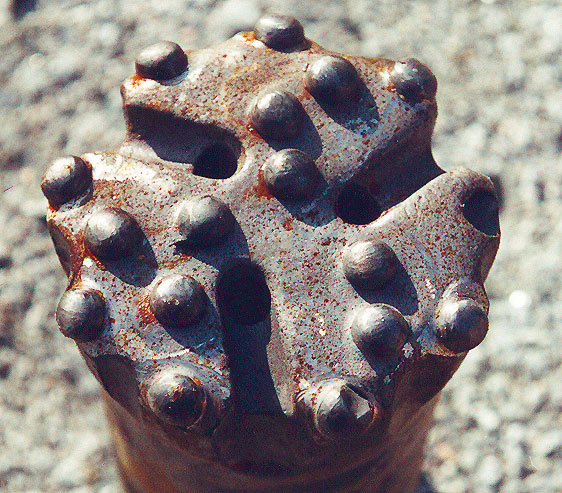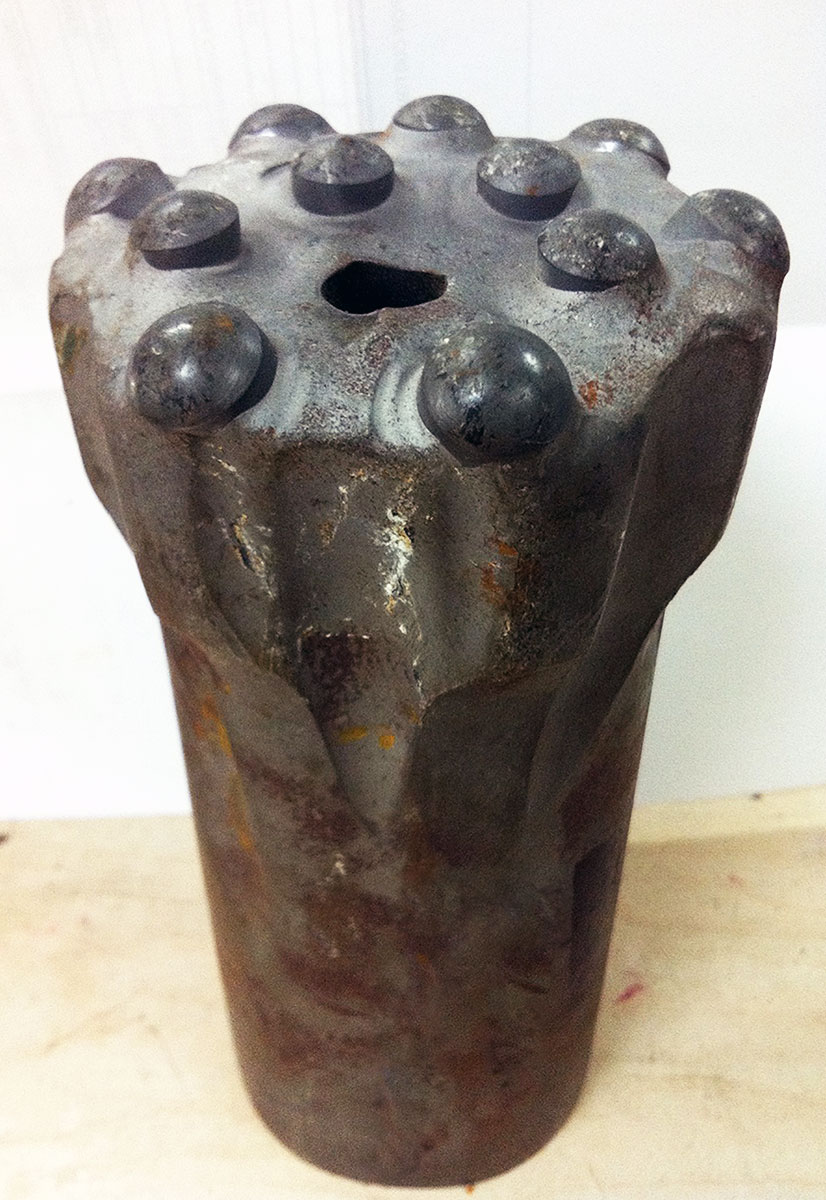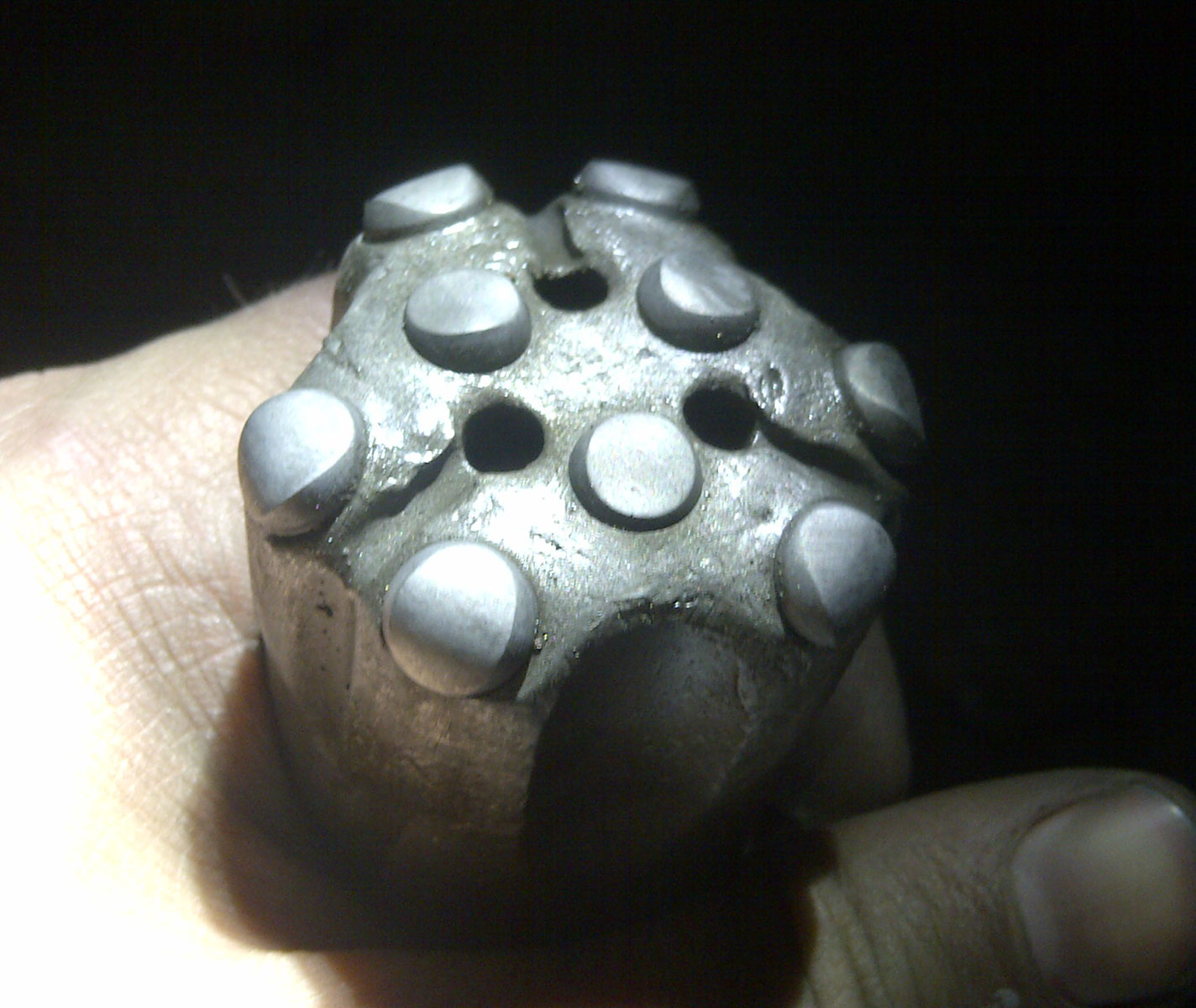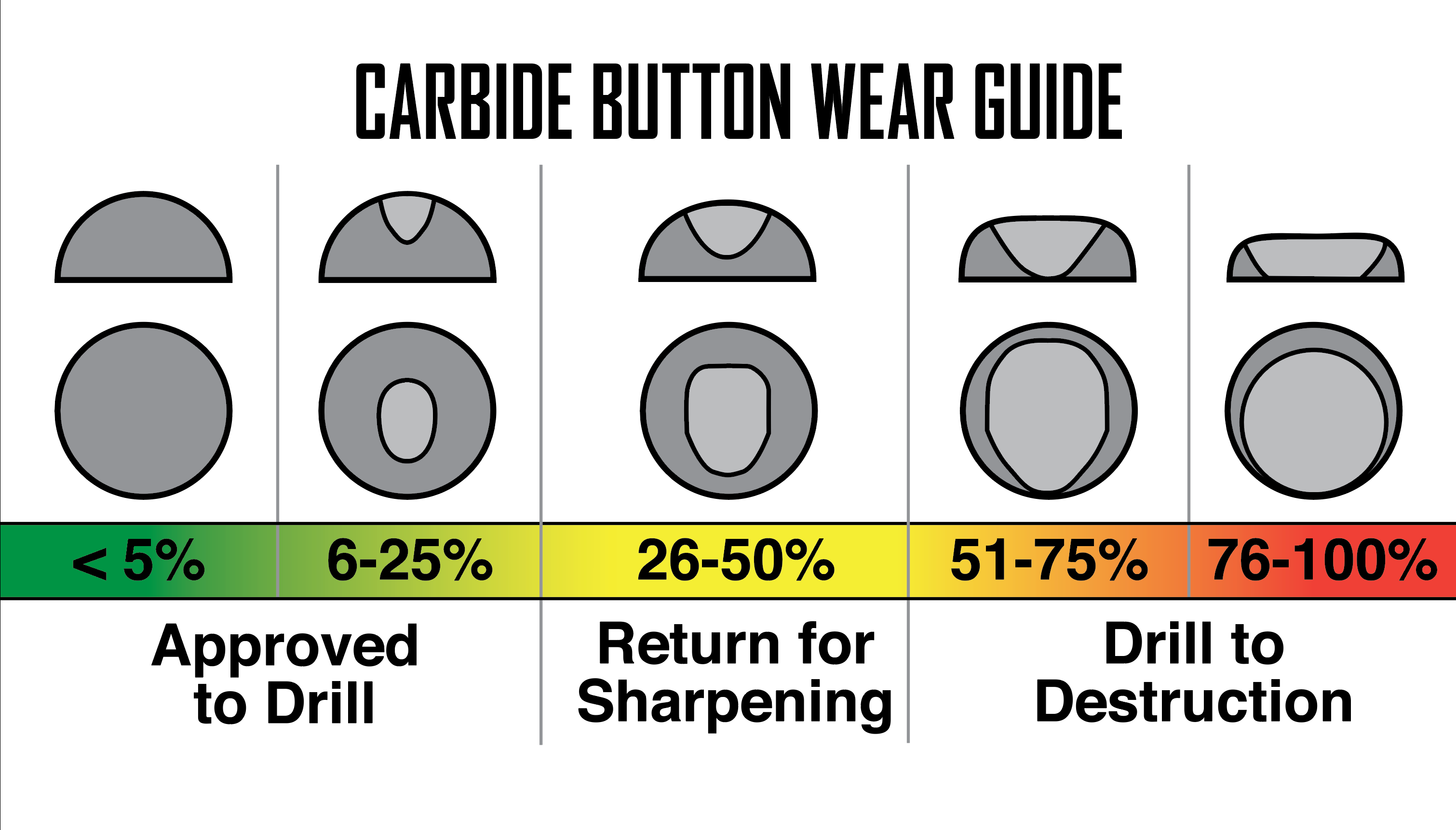BETRIEB MINE
7. November 2017
Überprüfen Sie Ihre Tasten: Bewährte Tipps für mehr Meter pro Bit
Dieser Artikel erschien ursprünglich in Ausgabe November 2017 von International Mining (erfordert Abonnement-Passwort)
Bohrunternehmer und Bergbauunternehmen verlassen sich auf ihr Werkzeug, um für jedes Projekt die höchste Produktivität und die niedrigsten Kosten pro Meter zu erzielen.
Beim Kauf von Top-Hammerknöpfen zum Beispiel ist die Auswahl eines qualitativ hochwertigen Produkts, das für die spezifischen Bodenbedingungen entwickelt wurde, nur der erste Schritt, um mehr Meter pro Bit zu erreichen. Um sicherzustellen, dass die Bits ordnungsgemäß verwendet und gewartet werden, ist es äußerst wichtig, eine hohe Kapitalrendite zu erzielen.
Warum ist Button Bit Wear wichtig?
Wenn ein oberer Hammerknopf scharf ist, ist die in das Gestein übertragene perkussive Energie optimal, was zu einem effektiven Gesteinsbruch und einer maximalen Durchdringungsrate für die gegebenen Bohrparameter führt.
Da sich an den Knöpfen Flachflächen (Wolframkarbid-Einsätze) entwickeln, wird die Energieausnutzung nicht mehr optimiert, was zu einer geringeren Durchdringungsrate und geringeren Produktivität führt. Wenn sich die Knöpfe abnutzen, ist der Bohrer beim Brechen des Gesteins weniger wirksam und die Energie wird über eine größere Oberfläche verteilt. Stattdessen wird das Gestein gemahlen und nicht geschnitten. Es werden kleinere Einschnitte erzeugt und Energie (die nicht mehr zum Brechen von jungfräulichem Gestein verwendet wird) wird in den Bohrstrang zurück reflektiert. Diese reflektierende Energie trägt zu einer erhöhten Belastung von Werkzeug, Drifter und Rigg bei. Generell gilt, dass die Auffrischung der Knöpfe, bevor die Abflachungen ein Drittel des Durchmessers erreichen, die Durchdringung / Produktivität aufrechterhält, eine maximale Bitausnutzung bietet und die Lebensdauer aller Bohrstrangkomponenten verlängert.
Wenn sich die Tastenflächen weiter entwickeln, bis sie als überbohrt gelten, verschlechtern sich Produktivität und Durchdringungsrate. In dieser Situation wird ein Großteil des Felsens, der mit den Knöpfen in Kontakt steht, erneut gebohrt, und die Stirnfläche des Stahlmeißels kann den Boden des Lochs berühren. Es werden immer weniger und kleinere Steinschläge produziert, und ein Großteil der Energie wird in den Bohrstrang zurück reflektiert. Dies bringt die Lebensdauer aller Bohrstrangkomponenten mit sich, trägt wesentlich zur Abweichung der Bohrungen bei, erhöht den Verschleiß und die Abnutzung der Komponenten der Bohranlage und führt insgesamt zu höheren Betriebskosten. Die überbohrten oberen Hammerknopf-Bits weisen gebrochene Tasten auf und wirken sich auf die Bohrproduktivität aus.
Die Abnutzungsprofile der Knöpfe unterscheiden sich je nach Bodenart und Bohrparameter:
Messgerät Verschleiß
Beim Bohren durch harte Materialien wie Sandstein und Quarzit und Bohren mit übermäßiger Drehung neigt der Verschleiß dazu, am Bohrerumfang größer zu sein. Wenn also die Knöpfe geschärft werden, ist der Durchmesser über das Messgerät kleiner oder gleich dem Durchmesser des Meißelkörpers. In dieser Situation neigt der Meißel dazu, sich im Loch festzuhalten (Ausmessen). Bohrer sollten einen Bohrerwechsel in Betracht ziehen oder den Abstand zwischen Sensor und Knopf auf den ursprünglichen (neuen) Zustand zurücksetzen.

Härtere Bodenbedingungen und das Bohren mit übermäßiger Rotation führen zu Verschleiß, der am Bohrerumfang tendenziell größer ist.
Duschgel
Beim Bohren in nicht abrasiven Materialien wird der Verschleiß von Hartmetall minimiert und die Bohrintervalle sind möglicherweise länger. Dies ermöglicht eine fortgesetzte Spanabfuhr um den Bohrmeißel und führt dazu, dass der Bohrmeißelkörper schneller abgetragen wird als die Karbide, die auch als "Body Wash" bezeichnet werden. Ein ähnlicher Verschleiß tritt in gebrochenen und losen Formationen auf, wo eine konstante Lochreinigung und Nachbohrung der Materialien erforderlich ist, um das Loch zu stabilisieren und das Loch während des Einzugs offen zu halten. Um einen Verlust oder ein Abscheren der Knöpfe unter diesen Bedingungen zu vermeiden, sollte der Vorsprung auf die ursprüngliche Höhe reduziert werden, indem die Schleifintervalle festgelegt werden.

Beim Bohren in nicht abrasiven Materialien tritt häufig Körperwäsche auf.
Über dem Bohren
Die nachteiligen Auswirkungen von Überbohrknöpfen sind möglicherweise nicht sofort ersichtlich. Das Ausführen von stumpfen Bohrmeißeln verlangsamt jedoch nicht nur die Bohrgeschwindigkeiten, sondern steigert die Kosten, da die Lebensdauer der Bohrgestängekomponenten, des Gesteinsbohrers und der Bohranlagenbauteile reduziert wird. Fehler beim vorzeitigen Einsetzen von Knopfbits werden wesentlich reduziert, wenn das Überbohren beseitigt wird und korrekte Schleifvorgänge durchgeführt werden.

Fehler beim vorzeitigen Einsetzen von Knopfbits werden wesentlich reduziert, wenn das Überbohren beseitigt wird und korrekte Schleifvorgänge durchgeführt werden.
Empfehlungen
Um das Beste aus Hammerknopf-Bits, Schulungsbohrern und dem Bergbau-Management in Bezug auf die Bit-Pflege herauszuholen, können Wartung und das Erkennen von übermäßigem Verschleiß die Investitionsrendite erhöhen.
1. Überprüfen Sie häufig die Bits
Um das Überbohren zu verhindern, sind Kenntnisse der Bodenverhältnisse und regelmäßige Inspektionen eines Knopfmeißels erforderlich. Um optimale Leistung und Lebensdauer zu gewährleisten, müssen die Bits geschärft werden, bevor die Abflachung 1/3 des Knopfdurchmessers übersteigt. Es wird empfohlen, mit einem technischen Vertreter zu arbeiten, um spezifische Richtlinien festzulegen, da der maximal empfohlene Verschleiß vor dem Umformen vom Tastenprofil abhängt.
Das Bohren in nicht abrasiven Böden kann zu Schlangenhaut (kleinen Rissen) auf der Knopfoberfläche führen. Wenn es nicht durch Schleifen entfernt wird, tritt ein Ausfall der Knopfermüdung auf.
2. Schleifen Sie hervorstehende Einsätze
Das Bohren in nicht abrasivem Gestein führt dazu, dass die Meißelfläche schneller abnutzt als die Einsätze. Ein übermäßiger Einsatzüberstand, dem keine ausreichende Stahlunterstützung fehlt, kann beim Bohren und beim Herausziehen des Meißels aus dem Loch leicht brechen. Um dies zu verhindern, schleifen Sie die Tasten, um die Höhe des Vorsprungs wiederherzustellen.
3. Button Schärfen und Umformen
Wenn der Knopfüberstand ausreichend ist, kann mit einem vorgeformten Diamantwerkzeug ("cups") ein zufriedenstellendes Nachschärfen erreicht werden. Das Schärfen wird durchgeführt, indem das Werkzeug fest gegen den Knopf gedrückt wird und die Maschine kreisförmig umläuft, um eine gleichmäßige Oberflächengüte zu erreichen. Diamantbeschichtete Werkzeuge sind zum Schneiden von Hartmetall und nicht von Stahl bestimmt. Es wird daher empfohlen, den Knopf so weit aus dem Gesicht zu ragen, dass eine Beschädigung des Bechers, der Spitze oder der Schleifmaschine vermieden wird.

Geschärfte Bits =
• Schnellere Durchdringungsraten
• Weniger Verschleiß an Bohrstrangkomponenten
• Reduzierte Ermüdungsfehler bei Werkzeugen
Es ist wichtig, ein effektives Schleifwerkzeugmanagement zu implementieren, da sich das Werkzeugprofil allmählich ändert und zu Tasten führt, die nicht mehr der gewünschten Form entsprechen. Technische Vertreter können mit spezifischen Empfehlungen behilflich sein.
Ein bisschen Training
Es ist immer wichtig, Werkzeug und Ausrüstung zu pflegen und zu warten. Denken Sie an ein bisschen Training für Bohrmaschinen, um das Beste aus den oberen Hammerknopf-Bits herauszuholen. Meistens kommen Bohrer zur Arbeit, um ihr Bestes zu geben und jeder möchte sich verbessern. Geben Sie ihnen die Gelegenheit, ihre Bohrgewohnheiten zu verbessern, indem Sie diese Tipps weitergeben.
Von einer kompletten Auswahl an Stangen, Meißeln und Schäften bis hin zu Kupplungen, Adaptern und anderem Zubehör bietet Boart Longyear erstklassige Hammerwerkzeuge für alle Schlagbohr- und Strahlanwendungen für Oberflächen- und Erdbohrungen.
Weitere Informationen zu den Boart Longyear-Hammerwerkzeugen Besuchen Sie unsere Webseite oder Laden Sie den Katalog herunter.
SICHERHEITSHINWEIS: Verwenden Sie beim Schleifen von Bohrmeißeln einen geeigneten Augenschutz, Masken und Belüftung. Schleifscheiben und Hartmetalleinsätze enthalten: Wolframkarbid; Kobalt; Tantal; Chrom; Nickel; Aluminium und Silizium. Beim Schleifen von Wolframkarbid-Einsätzen werden Partikel freigesetzt, die diese Elemente enthalten. Dies kann Haut, Augen, Nase und Rachen reizen und zu Lungenschäden führen.
HALTEN SIE IHR WERKZEUG IN TOP-FORM
Laden Sie die vollständige Anleitung herunter Halten Sie Ihr Werkzeug in Topform Lesen Sie mehr über Bitabnutzungsmuster, Produktwartung und Best Practice-Empfehlungen.
HERUNTERLADEN
[pardot-form height="770" id="2495" title="Download Keeping your tooling in top shape PDF"]



